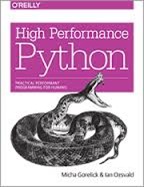 High Performance Python by Micha Gorelick and Ian Ozsvald is nominally a book about improving the speed and memory performance of your programs. Along the way it provides insight into some more advanced aspects of Python programming, including how the language works under the hood.
High Performance Python by Micha Gorelick and Ian Ozsvald is nominally a book about improving the speed and memory performance of your programs. Along the way it provides insight into some more advanced aspects of Python programming, including how the language works under the hood.
The book starts with tools for analysing the speed and memory performance of programs at global, function and line level. The authors emphasis the importance making these measurements, and using unit testing to ease the process of optimisation. Blindly optimising where you *think* the problem lies is never a good idea.
The next set of chapters talk about some core Python data structures a little about their implementation and relative performance. These include lists and tuples, dictionaries and sets, iterators and generators and matrices and vectors.It is here that the numpy library is introduced, and it is treated almost as a core Python library in its importance.
The difference between range and xrange in Python 2 is striking: if you wish to execute a loop some number of times then range builds a list of size that number of elements and xrange makes a generator and therefore xrange uses far less memory.
The next few chapters cover compiling Python to C for speed increases, concurrency, the multiprocessing module and clusters. Typically chapters take an example (Julia sets, diffusion equations, estimating pi, finding primes) and demonstrate the speedups which can be made, from the routine to the ridiculous. The authors point out when further optimisation is a bit pointless.
For compiling to C, there are a number of options of varying coverage and maturity. Cython offers the most mature, widest coverage but at the cost of making breaking changes to code. Other newer solutions include Numba and PyPy, they do not require breaking changes to code but they are less mature and in the case of PyPy do not support the important numpy library.
Concurrency is about making better use of a single processor using asynchronous methods, here there are libraries such as gevent and tornado.
For parallel processing most focus is on the multiprocessing library, most of the book is platform agnostic but this chapter is based on the Linux implementation of Python.I hadn’t realised before that “embarrassingly parallel” had a specific meaning i.e. that there is no need for interprocess communication for the problem at hand.
The coverage of computing clusters is fairly cursory, this isn’t really the focus of this book and as the authors highlight: running clusters of machines can bring a significant administration overhead.
The book finishes with a chapter on reducing RAM usage, either by choice of intrinsic data types or using probabilistic data structures such as the Bloom filter which offer an approximate answer for vastly less memory usage. Also included are the Morris Counter which provides an approximate counter in 1 byte of storage, I must admit to being bemused as to when I would need such a thing.
Finally, there are what I refer to as “war stories” from practitioners in the field. I really liked these, one of the difficulties in working in technology is the constant stream of options to choose from, often with no clear frontrunner, so learning how others have approached problems is really handy. Here Celery, the Distributed Task Queue, and ElasticSearch get multiple mentions.
Overall the book is well-produced and readable. It occasionally lapses into the problem of inviting the reader to admire the colour in a greyscale printed plot. In other places I felt the example code could have presented up front in its entirety rather than being dribbled out in bits. In the chapter on Using less RAM, I felt important things were discussed (tries and directed-acyclic word graphs (DAWGs) before they were introduced which was a bit confusing. Tries and DAWGs are systems for the compact storage of text, and are both tree-like structures – I hadn’t come across these before.
In some ways this book is more about productionisation rather than performance. For the straightforward non-production data analysis work I’ve done I can imagine being a bit smarter about my choice of data structures and using profiling to be aware the slow points are as a result of this book. In the repeated reanalysis cycle it is nice to have something run in a minute rather than 20, but is it worth a day of development time? I would likely only turn to compilation, concurrency and multiprocessing if I were going to use a particular analysis regularly, or my anticipated run time was going to be measured in days without optimization.
I recommend this book to anyone looking to advance their understanding of Python, and speed up their code.

